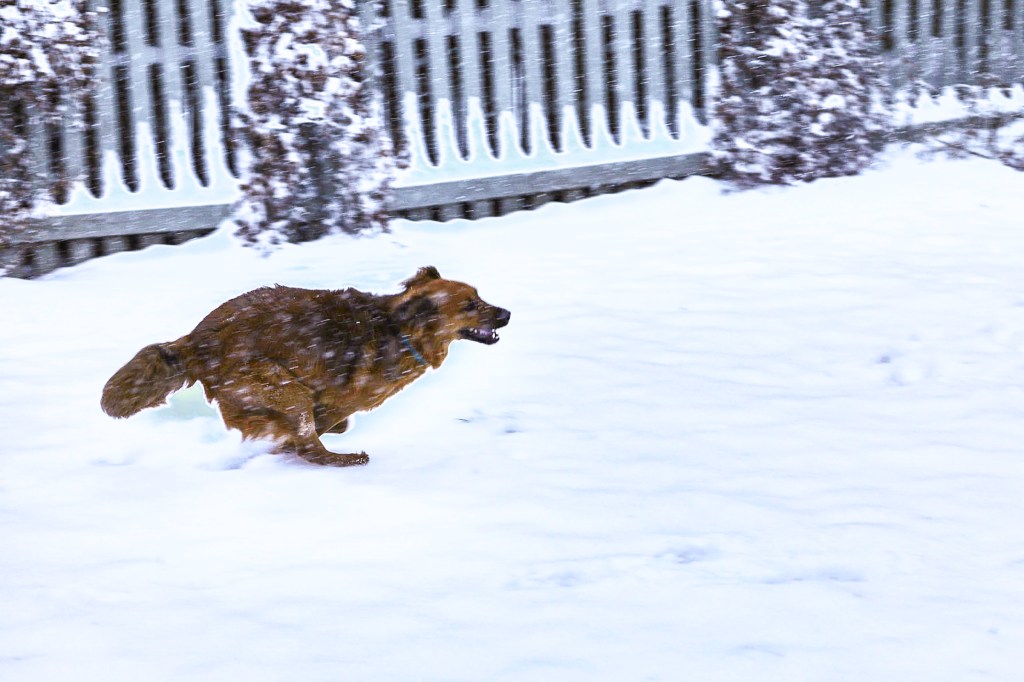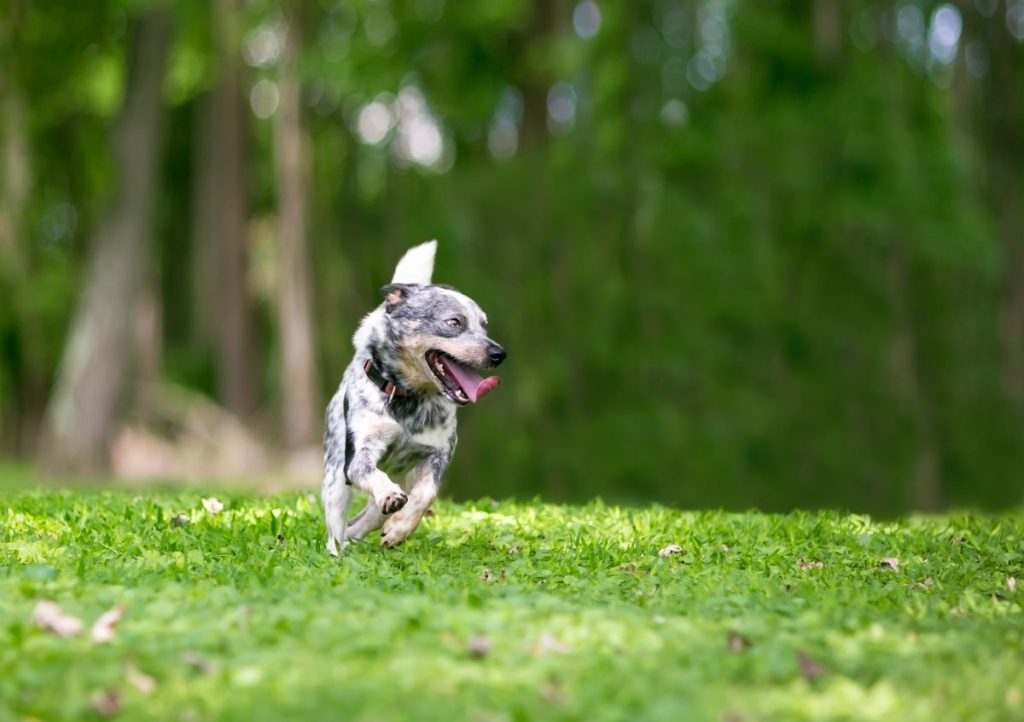If you’ve ever seen your dog suddenly burst into a frenetic display of running in circles or darting back and forth, then you’ve witnessed the adorable and bewildering phenomenon known as “the zoomies.” While this energetic behavior can be entertaining, it also leaves many pet parents scratching their heads, wondering why their normally placid pooch has turned into a hyperactive whirlwind. So, what exactly is the meaning of zoomies, and what prompts dogs to suddenly engage in this frantic behavior?
What are dog zoomies?
You might be wondering, what is “zoomies” slang for? Essentially, the term “zoomies” is slang for a behavior officially known as Frenetic Random Activity Periods (FRAPs). It’s when your dog appears to be overtaken by a sudden, explosive energy that propels them to dash around in wild, exuberant runs. They might zoom around in circles, back and forth, or in no particular pattern at all. This display of sheer joy and energy usually lasts for a few minutes before they come to a stop, often just as suddenly as they started.
Dogs exhibiting the zoomies will usually have flattened ears, a playful grin, and raised hackles. While intense, zoomies are not typically aggressive but rather just enthusiastic releases of pent-up energy. Often, dogs will zoom by themselves, though some pair their runs with toys or other dogs.
Why do dogs get the zoomies?

Veterinarians and dog behavior experts have a few theories about what causes the zoomies in dogs. Here are some of the most common reasons:
They need to burn excess energy
One of the most straightforward reasons why your dog gets the zoomies is simply an accumulation of excess energy. Just like humans, dogs can get restless if they don’t have an outlet for their energy. This is particularly common in high-energy breeds or younger dogs who require lots of exercise and mental stimulation. When they’ve been cooped up for too long or haven’t had a good run in a while, the zoomies can be a way for your dog to blow off some steam in a quick burst of energy.
Dog zoomies are a sign of happiness
Have you noticed that the zoomies often happen at times when your dog seems particularly happy or excited? Maybe you’ve just come home from work, or perhaps your dog has just had a very satisfying play session or bath. These bursts of joyful energy may indicate your dog’s happiness or excitement. It’s an impulsive way for them to show you just how good they’re feeling at that moment.
A reaction to stress or overstimulation
Conversely, the zoomies can also be a reaction to stress or overstimulation. In some cases, if your dog feels overwhelmed — perhaps by a loud noise, a stressful grooming session, or an unfamiliar environment — they might respond with a zoomie episode. It’s their means of relieving some of the stress they’re experiencing. Understanding your dog’s stressors and managing their environment can help minimize stress-induced zoomies.
They are a part of natural instinct
Dogs, much like their wolf ancestors, are built to run. The zoomies can be seen as a remnant of their natural instinct to roam and sprint. This behavior is a normal part of canine psychology and shows that your pet is healthy and has natural, instinctual urges. It is a spontaneous reminder that despite being domesticated, dogs still retain elements of their wild lineage.
Zoomies encourage social bonds
Zoomies can also play a role in encouraging social bonds between dogs. If you have more than one canine, or if your dog plays with others at the dog park, you might have noticed that zoomie episodes can be contagious. When one dog starts, others may join in, leading to a communal session of joyful running. This behavior can help reinforce social bonds and promote positive interactions between dogs.
Are zoomies good or bad?
In most cases, zoomies are normal and healthy dog behaviors. They indicate that your pet has excess energy to burn and is feeling lively enough to express it. This spontaneous eruption of energy can be crucial for dogs’ physical fitness and mental health. It’s a natural behavior that allows them to release pent-up energy and stress, ensuring they maintain a balanced mood and are less prone to behavior problems linked to boredom or excessive energy.
However, while zoomies are typically a positive sign, it’s important to ensure the safety of your dog during these frenetic outbursts. Some pups may zoom to the point of minor injury by running into objects or falling. Make sure your pet is in a safe, enclosed space where they can’t hurt themselves or knock over items. If your pet frequently gets the zoomies, consider incorporating more structured physical activity and mental stimulation into their daily routine to help manage their energy levels more consistently. Remember, observing your pet’s behavior and ensuring they are engaged in a safe environment is key.
Are dogs happy when they have the zoomies?

Zoomies are not only entertaining to watch but also indicative of your dog’s emotional state. As mentioned earlier, when your dog gets the zoomies, it’s generally a sign they are overflowing with happiness and excess energy. This frenetic random activity period is a healthy expression of joy in a physical and unrestrained manner. Typically, a zoomies session is followed by a period of relaxation or even a nap, suggesting that this activity is an effective way for dogs to regulate their energy levels and maintain their happiness. Watching for a relaxed posture, wagging tail, and playful demeanor can assure you that your dog is simply having a great time.
So, the next time your puppy has the zoomies, take it as a compliment. You’re doing a good job keeping them healthy and content!
Why do dogs get the zoomies after a bath?
If you’ve ever noticed your dog getting the zoomies right after a bath, you might be surprised to learn that there are a few reasons why. This phenomenon is quite common and can be attributed to a sense of relief and freedom from the bath itself. While many dogs tolerate baths, they aren’t necessarily the most enjoyable experience for them. The sudden burst of energy and joy your dog exhibits by running around might be them expressing their happiness that the bath is over. Additionally, the sensation of being wet could also trigger an instinctual response to dry off quickly by moving fast and shaking their body.
Is it normal for my dog to do zoomies after a walk?

Yes, it’s quite normal for dogs to engage in zoomies after a walk. This is especially the case if they’ve been on a leash and suddenly find themselves in an open space where they can run freely. The change in environment can often unleash pent-up energy, resulting in a delightful display of your dog joyously running around.
Do dogs and puppies often have zoomies at night or before bed?
Many dogs and puppies get zoomies at night or before bed, which might seem counterintuitive as it’s a time to wind down. However, this can be due to accumulated energy over the day or as part of their natural routine to expend all remaining energy before bedtime. Puppies, in particular, may exhibit the zoomies at night since they have an abundance of energy to burn.
Why is my puppy or dog biting during zoomies?
When your puppy or dog engages in zoomies, biting can sometimes be part of the excitement. It’s important to understand that this behavior is typically a form of playful expression and not an act of aggression. During zoomies, your dog’s arousal levels are heightened. Consequently, they may lose some impulse control, leading to nipping or biting as they zoom past you. This is especially common in puppies who are still learning boundaries and may not yet fully understand the difference between appropriate and inappropriate play behaviors.
Ensuring your puppy or dog has plenty of physical and mental stimulation throughout the day can help mitigate the intensity of zoomies. Moreover, it’s crucial to maintain a calm demeanor during these bursts of energy. Attempting to catch a zooming dog may trigger a game of chase. Simply let the episode run its course, and redirect their biting towards toys or chewable items rather than your hands or feet. With age and guidance, most dogs outgrow the zoomies phase.









